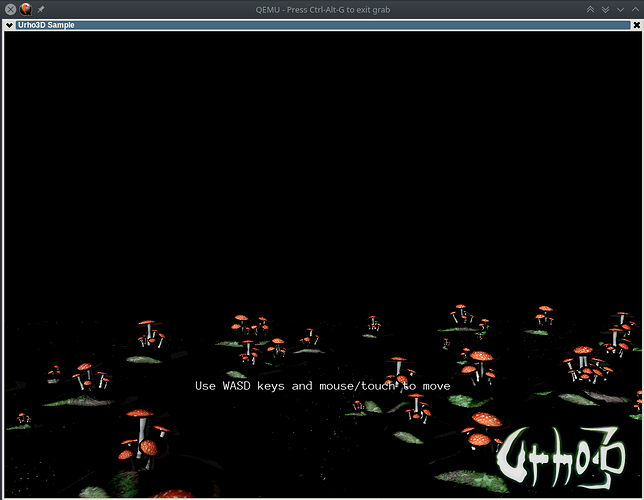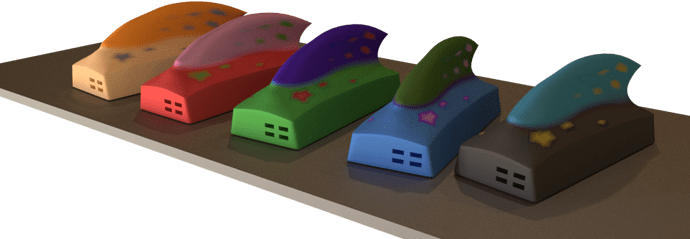@urnenfeld
I finally got urho3d-samples to run using the gpu (mali450). Here are some benchmarks, just in case you are interested:
- 03 - Sprites 35fps
- 11 - Phyiscs (before shooting blocks:42 afterwards a steady 27 no matter how much I push the system)
- 13 - Ragdoll 43
- 18 - Character 42
- 19 - Vehicle 25
- 25 - Particles 60
@SirNate0 Setting AS_MAX_PORTABILITY preprocessor-definition doesn’t change a thing. Here the error-log with ‘VERBOSE=1 make’. Maybe you can see something out of it.
[ 63%] Building CXX object Source/Urho3D/CMakeFiles/Urho3D.dir/AngelScript/AudioAPI.cpp.o
cd /home/odroid/_dev/extprojects/_build/Urho3D/Source/Urho3D && /usr/bin/c++ -DGENERIC_ARM -DHAVE_SINCOSF -DHAVE_STDINT_H -DSTBI_NEON -DTOLUA_RELEASE -DURHO3D_ANGELSCRIPT -DURHO3D_FILEWATCHER -DURHO3D_IK -DURHO3D_IS_BUILDING -DURHO3D_LOGGING -DURHO3D_LUA -DURHO3D_NAVIGATION -DURHO3D_NETWORK -DURHO3D_PHYSICS -DURHO3D_PROFILING -DURHO3D_STATIC_DEFINE -DURHO3D_THREADING -DURHO3D_URHO2D -DURHO3D_WEBP -I/home/odroid/_dev/extprojects/_build/Urho3D/Source/Urho3D -I/home/odroid/_dev/extprojects/Urho3D/Source/Urho3D -I/home/odroid/_dev/extprojects/_build/Urho3D/include/Urho3D/ThirdParty -I/home/odroid/_dev/extprojects/_build/Urho3D/include/Urho3D/ThirdParty/Bullet -I/home/odroid/_dev/extprojects/_build/Urho3D/include/Urho3D/ThirdParty/Detour -I/home/odroid/_dev/extprojects/_build/Urho3D/include/Urho3D/ThirdParty/Lua -DAS_MAX_PORTABILITY=1 -std=gnu++11 -Wno-invalid-offsetof -fsigned-char -pipe -march=armv8-a -pthread -fdiagnostics-color=auto -include "/home/odroid/_dev/extprojects/_build/Urho3D/Source/Urho3D/Precompiled.h" -O3 -DNDEBUG -o CMakeFiles/Urho3D.dir/AngelScript/AudioAPI.cpp.o -c /home/odroid/_dev/extprojects/Urho3D/Source/Urho3D/AngelScript/AudioAPI.cpp
In file included from /home/odroid/_dev/extprojects/Urho3D/Source/Urho3D/AngelScript/../AngelScript/../AngelScript/Addons.h:35:0,
from /home/odroid/_dev/extprojects/Urho3D/Source/Urho3D/AngelScript/../AngelScript/APITemplates.h:25,
from /home/odroid/_dev/extprojects/Urho3D/Source/Urho3D/AngelScript/AudioAPI.cpp:25:
/home/odroid/_dev/extprojects/_build/Urho3D/include/Urho3D/ThirdParty/AngelScript/angelscript.h:45:0: warning: "AS_MAX_PORTABILITY" redefined
#define AS_MAX_PORTABILITY
<command-line>:0:0: note: this is the location of the previous definition
In file included from /home/odroid/_dev/extprojects/_build/Urho3D/include/Urho3D/ThirdParty/AngelScript/wrapmacros.h:31:0,
from /home/odroid/_dev/extprojects/_build/Urho3D/include/Urho3D/ThirdParty/AngelScript/angelscript.h:1967,
from /home/odroid/_dev/extprojects/Urho3D/Source/Urho3D/AngelScript/../AngelScript/../AngelScript/Addons.h:35,
from /home/odroid/_dev/extprojects/Urho3D/Source/Urho3D/AngelScript/../AngelScript/APITemplates.h:25,
from /home/odroid/_dev/extprojects/Urho3D/Source/Urho3D/AngelScript/AudioAPI.cpp:25:
/home/odroid/_dev/extprojects/Urho3D/Source/Urho3D/AngelScript/../AngelScript/APITemplates.h: In function ‘void Urho3D::RegisterSubclass(asIScriptEngine*, const char*, const char*)’:
/home/odroid/_dev/extprojects/_build/Urho3D/include/Urho3D/ThirdParty/AngelScript/wrap16.h:2916:67: error: expected primary-expression before ‘)’ token
#define WRAP_OBJ_LAST(name) (::gw::id(name).TMPL ol< name >())
^
/home/odroid/_dev/extprojects/_build/Urho3D/include/Urho3D/ThirdParty/AngelScript/wrapmacros.h:74:102: note: in expansion of macro ‘WRAP_OBJ_LAST’
#define RegisterObjectMethodFasCALL_CDECL_OBJLAST(clsdcl,decl,fun) RegisterObjectMethod(clsdcl,decl, WRAP_OBJ_LAST(fun), asCALL_GENERIC); //assert(r >= 0);
^~~~~~~~~~~~~
/home/odroid/_dev/extprojects/_build/Urho3D/include/Urho3D/ThirdParty/AngelScript/wrapmacros.h:70:64: note: in expansion of macro ‘RegisterObjectMethodFasCALL_CDECL_OBJLAST’
#define RegObjectMethodIndirect(clsdcl,decl, F, clsfunc, kind) RegisterObjectMethod##F##kind (clsdcl,decl,clsfunc) // ... = decl or it = decl, cls for asCall_ThisCall
^~~~~~~~~~~~~~~~~~~~
/home/odroid/_dev/extprojects/_build/Urho3D/include/Urho3D/ThirdParty/AngelScript/wrapmacros.h:68:35: note: in expansion of macro ‘RegObjectMethodIndirect’
#define RegisterObjectMethod(...) RegObjectMethodIndirect(__VA_ARGS__)
^~~~~~~~~~~~~~~~~~~~~~~
/home/odroid/_dev/extprojects/Urho3D/Source/Urho3D/AngelScript/../AngelScript/APITemplates.h:224:13: note: in expansion of macro ‘RegisterObjectMethod’
engine->RegisterObjectMethod(classNameT, declReturnU.CString(), asFUNCTION((RefCast<T, U>)), asCALL_CDECL_OBJLAST);^M
^~~~~~~~~~~~~~~~~~~~
/home/odroid/_dev/extprojects/_build/Urho3D/include/Urho3D/ThirdParty/AngelScript/wrap16.h:2916:67: error: expected primary-expression before ‘)’ token
#define WRAP_OBJ_LAST(name) (::gw::id(name).TMPL ol< name >())
^
/home/odroid/_dev/extprojects/_build/Urho3D/include/Urho3D/ThirdParty/AngelScript/wrapmacros.h:74:102: note: in expansion of macro ‘WRAP_OBJ_LAST’
#define RegisterObjectMethodFasCALL_CDECL_OBJLAST(clsdcl,decl,fun) RegisterObjectMethod(clsdcl,decl, WRAP_OBJ_LAST(fun), asCALL_GENERIC); //assert(r >= 0);
^~~~~~~~~~~~~
/home/odroid/_dev/extprojects/_build/Urho3D/include/Urho3D/ThirdParty/AngelScript/wrapmacros.h:70:64: note: in expansion of macro ‘RegisterObjectMethodFasCALL_CDECL_OBJLAST’
#define RegObjectMethodIndirect(clsdcl,decl, F, clsfunc, kind) RegisterObjectMethod##F##kind (clsdcl,decl,clsfunc) // ... = decl or it = decl, cls for asCall_ThisCall
^~~~~~~~~~~~~~~~~~~~
/home/odroid/_dev/extprojects/_build/Urho3D/include/Urho3D/ThirdParty/AngelScript/wrapmacros.h:68:35: note: in expansion of macro ‘RegObjectMethodIndirect’
#define RegisterObjectMethod(...) RegObjectMethodIndirect(__VA_ARGS__)
^~~~~~~~~~~~~~~~~~~~~~~
Maybe you know what’s going on there














